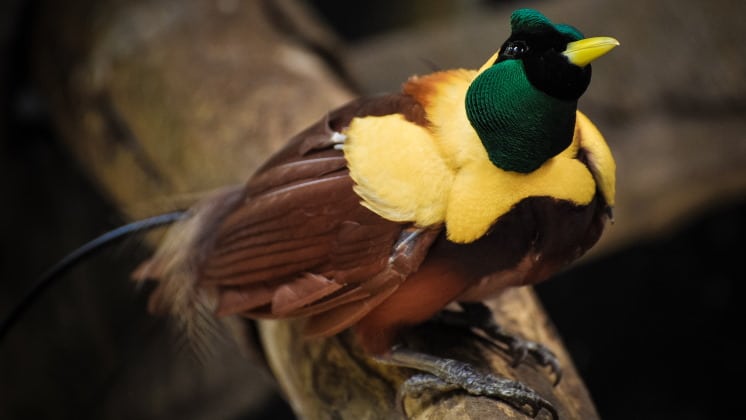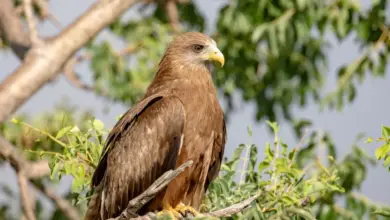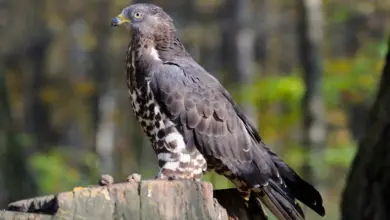The King Vultures, Sarcoramphus papa, is a large bird found in Central and South America. It is a member of the New World vulture family Cathartidae.
This vulture lives predominantly in tropical lowland forests stretching from southern Mexico to northern Argentina, though some believe that William Bartram’s Painted Vulture of Florida may be of this species.
It is the only surviving member of the genus Sarcoramphus, though fossil members are known.
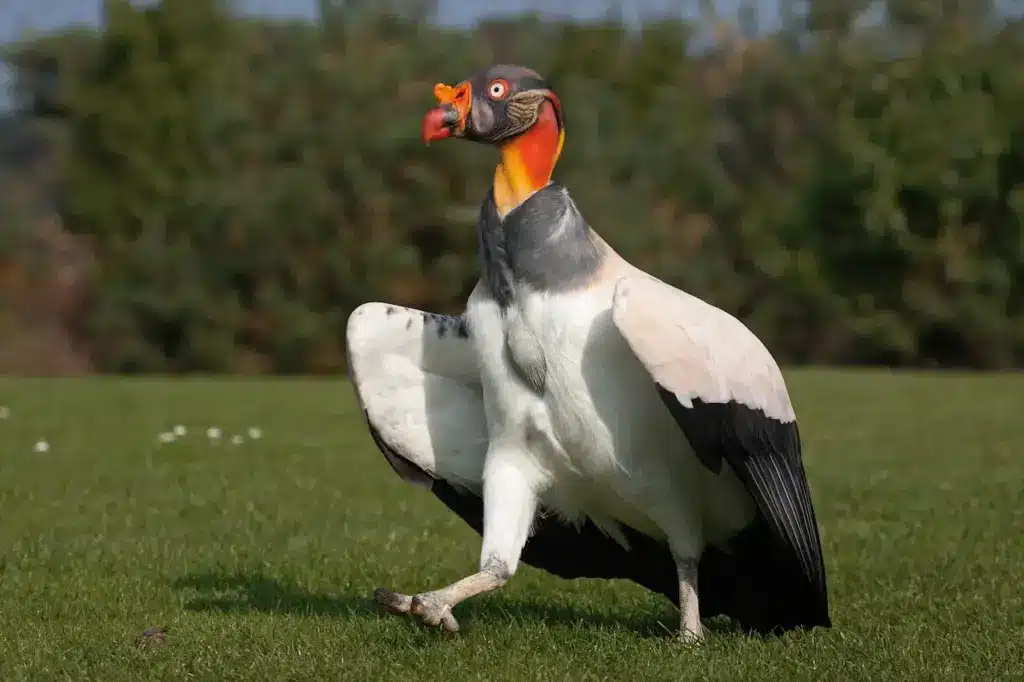
It is large and predominantly white, with grey-to-black ruff, flight, and tail feathers. Its head and neck are bald, with the skin colour varying, including yellow, orange, blue, purple, and red.
The King Vulture has a very noticeable yellow fleshy caruncle on its beak. This vulture is a scavenger and it often makes the initial cut into a fresh carcass. It also displaces smaller New World vulture species from a carcass. King Vultures have been known to live for up to 30 years in captivity.
King Vultures were popular figures in the Mayan codices as well as in local folklore and medicine. Though currently listed as Least Concern by the IUCN, they are decreasing in number, due primarily to habitat loss.
Taxonomy and systematics
The King Vulture was originally described by Carl Linnaeus in 1758 in the tenth edition of his Systema Naturae as Vultur papa. It was reassigned to the genus Sarcoramphus in 1805 by André Marie Constant Duméril. The generic name is a New Latin compound formed from the Greek words ???? (sarx, “flesh”, the combining form of which is ?????-) and ?????? (rhamphos, “crooked beak of bird of prey”).
The genus name is often misspelled as Sarcorh>amphus, improperly retaining the Greek rough breathing despite agglutination with the previous word-element. The bird was also assigned to the genus Gyparchus by Constantin Wilhelm Lambert Gloger in 1841, but this classification is not used in modern literature since Sarcoramphus has priority as the earlier name.
The King Vulture’s closest living relative is the Andean Condor, Vultur gryphus. Some authors have even put these species in a separate subfamily from the other New World vultures, though most authors consider this subdivision unnecessary.
There are two theories on how the King Vulture earned the “King” part of its common name. The first is that the name is a reference to its habit of displacing smaller vultures from a carcass and eating its fill while they wait.
An alternative theory reports that the name is derived from Mayan legends, in which the bird was a king who served as a messenger between humans and the gods. This bird was also known as the “White Crow” by the Spanish in Paraguay.
The exact systematic placement of the King Vulture and the remaining six species of New World vultures remains unclear. Though both are similar in appearance and have similar ecological roles, the New World and Old World vultures evolved from different ancestors in different parts of the world.
Just how different the two are is currently under debate, with some earlier authorities suggesting that the New World vultures are more closely related to storks. More recent authorities maintain their overall position in the order Falconiformes along with the Old World vultures or place them in their order, Cathartiformes.
The South American Classification Committee has removed the New World vultures from Ciconiiformes and instead placed them in Incertae sedis, but notes that a move to Falconiformes or Cathartiformes is possible.
Fossil record and evolution
The genus Sarcoramphus, which today contains only the King Vulture, had a wider distribution in the past. The Kern Vulture, Sarcoramphus kernense, lived in southwestern North America during the mid-Pliocene (Piacenzian), some 3.5-2.5 million years ago). It was a little-known component of the Blancan/Delmontian faunal stages.
The only material is a broken distal humerus fossil, found at Pozo Creek, Kern County, California. As per Loye H. Miller’s original description, “[c]ompared with [S. papa] the type conforms in general form and curvature except for its greater size and robustness.”
The large span in time between the existence of the two species suggests that the Kern Vulture might be distinct, but as the fossil is somewhat damaged and rather non-diagnostic, even assignment to this genus is not completely certain.
During the Late Pleistocene, another species probably assignable to the genus, Sarcoramphus fisheri, occurred in Peru. This would have been the chronospecies ancestral to the present-day King Vulture, or possibly a sister species. Few avian species of today evolved after that time, and of those that did most are small, short-lived Passeriformes (Perching Birds).
A supposed King Vulture relative from Quaternary cave deposits in Cuba turned out to be bones of the eagle-sized hawk (Buteogallus borrasi (formerly in Titanohierax).
Little can be said of the evolutionary history of the genus, mainly because remains of other Neogene New World vultures are usually younger or even more fragmentary. The iterators held sway over the ecological niche of the extant group, especially in North America.
The Kern Vulture seems to slightly precede the main bout of the Great American Interchange, and, notably, the living diversity of New World vultures seems to have originated out of Central America.
The Kern Vulture would then seem to represent a northwards divergence possibly sister to the S. fisheri – S. papa lineage.
Be that as it may, the fossil record, though scant, supports the theory that the ancestral King Vultures and South American Condors separated at least some 5 mya.
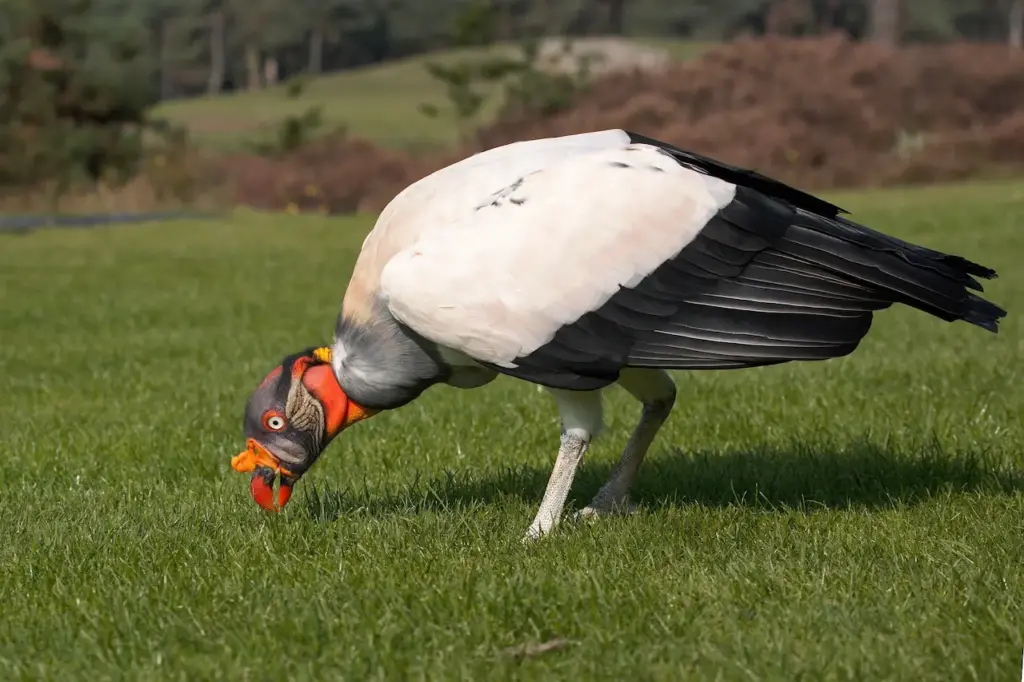
Bartram’s “Painted Vulture”
A “Painted Vulture” (“Sarcoramphus sacra” or “S. papa sacra”) is described in William Bartram’s notes of his travels in Florida during the 1770s. The notes were considerably altered and expanded in the printed edition, possibly by an editor who had seen images of the King Vulture and believed the bird briefly and equivocally described by Bartram to be a King Vulture and therefore fleshed out the details as he saw fit.
Several researchers have attempted to prove the former existence of a King Vulture relative in Florida at this late date, suggesting that the population was in the process of extinction and finally disappeared during a cold spell. However, Bartram saw his “Painted Vulture” in the area from which the Northern Caracara was later described. This bird was common and conspicuous in Bartram’s days, but it is conspicuously missing from Bartram’s notes if the “Painted Vulture” is accepted as a Sarcoramphus.
While the original notes are somewhat ambiguous regarding the appearance of the bird, the description does fit that of a caracara. The birds’ behaviour, as recorded by Bartram, is in complete agreement with the caracara. For example, Bartram observed the birds following wildfires to scavenge for burned insects and box turtles. Such behaviour is typical of caracaras, but the larger and shorter-legged King Vultures are not well adapted for walking.
Description
The adult King Vulture is the most strikingly coloured of the New World vultures.
It is predominantly white, though its ruff, flight, and tail feathers range from grey to an opalescent black. The white plumage also has a slight rose-yellow tinge to it. It has a thick, strong bill that, whilst the most powerful among the New World vultures, is quite small compared to that of other large birds of prey. This bill has a hooked tip and a sharp cutting edge.
The bird has broad wings and a short, broad, and square tail. Its eyes are straw-colored and it has keen eyesight. Unlike some New World vultures, the King Vulture lacks eyelashes. The King Vulture also has a highly noticeable yellow fleshy crest on its orange and black bill; this caruncle does not fully form until the bird’s fourth year. It also has grey legs and long, thick claws.
The vulture is minimally sexually dimorphic, with no difference in plumage and little in size between males and females.
The juvenile vulture has a dark bill and eyes, and a downy, grey neck that soon begins to turn the orange of an adult. Younger vultures are a slate grey overall, and, while they look similar to the adult by the third year, they do not completely moult into adult plumage until they are approximately five or six years of age.
The vulture’s head and neck are featherless as an adaptation for hygiene, though there are black bristles on parts of the head; this lack of feathers prevents bacteria from the carrion it eats from ruining its feathers and exposes the skin to the sterilizing effects of the sun. The skin on the neck and head can be of many colours, including yellow, orange, blue, purple, and red. The bird’s skin is also wrinkled near the ear and back of the neck.
Excluding the two species of condors, the King Vulture is the largest of the New World vultures. Its overall length ranges from 67–81 centimetres (27–32 in) and its wingspan is 1.2–2 meters (4–6.6 ft). Its weight ranges from 2.7–4.5 kilograms (6–10 lb).
Distribution and habitat
The King Vulture inhabits an estimated 14 million square kilometres between southern Mexico and northern Argentina. In South America, it does not live west of the Andes, except in western Ecuador, north-western Colombia, and far north-western Venezuela. It primarily inhabits undisturbed tropical lowland forests as well as savannas and grasslands with these forests nearby. It is often seen near swamps or marshy places in the forests.
This bird is often the most numerous or only vulture present in primary lowland forests in its range, but in the Amazon rainforest, it is typically outnumbered by the Greater Yellow-headed Vulture, while typically outnumbered by the Lesser Yellow-headed, Turkey, and American Black Vulture in more open habitats. King Vultures generally do not live above 1200 meters (4000 ft). They inhabit the emergent forest level, or above the canopy.
Ecology and behavior
The King Vulture is an expert glider, sometimes soaring for hours without flapping its wings. While in flight, its wings are held dihedral, or flat with slightly raised tips, and from a distance, the vulture can appear to be headless while in flight. Its wing beats are deep and strong. Despite its size and gaudy colouration, this vulture is quite inconspicuous when it is perched in trees. While perched, it holds its head lowered and thrust forward.
It is non-migratory and, unlike the Turkey, Lesser Yellow-headed, and American Black Vulture, it generally lives alone or in small family groups. However, it can gather in large groups at a carcass. King Vultures have lived up to 30 years in captivity, though their lifespan in the wild is unknown.
This vulture uses urohydrosis, defecating on its legs, to lower its body temperature. Despite its bill and large size, it is relatively unaggressive at a kill and will normally back down rather than fight. The King Vulture lacks a voice box, though it can make low croaking noises and wheezing sounds.
Its only natural predators are snakes, which will prey upon the vulture’s eggs and young, and large cats such as jaguars, which may surprise and kill an adult vulture at a carcass.
Diet
The King Vulture feeds solely on carrion and, unlike some New World vultures, is not known to kill sick or dying animals for food.
It often eats stranded fish along river banks but does not come to village refuse dumps for food.
Though it has keen eyesight which can help it locate food, there are two theories regarding how it specifically finds carrion. Some argue that it uses its sense of smell to find animal carcasses. Others argue that it does not have a sense of smell, and instead follows the smaller Turkey Vultures and Greater Yellow-headed Vultures, which do have a sense of smell, to a carcass.
A recent study demonstrated that the King Vulture could find carrion in the forest without the aid of other vultures, suggesting that it locates food using a sense of smell.
The King Vulture primarily eats carrion found in the forest, though it is known to venture onto nearby savannas in search of food. Once it has found a carcass, the King Vulture displaces the other vultures because of its large size and strong bill. However, when it is at the same kill as the larger Andean Condor, the King Vulture always defers to it.
Using its bill to tear, it makes the initial cut in a fresh carcass. This allows the smaller, weaker-beaked vultures, which can not open the hide of a carcass, access to the carcass after the King Vulture has fed.
The vulture’s tongue is rasp-like, which allows it to pull flesh off of the carcass’s bones. Generally, it only eats the skin and harder parts of the tissue of its meal.
Reproduction
An adult King Vulture sexually matures when it is about four or five years old. The birds mainly breed during the dry season. The vultures give an elaborate courting display in which the pair circle each other on the ground while flapping their wings and making loud wheezing noises and snorting sounds while mating.
King Vultures mate for life and generally lay a single unmarked white egg in its nest in a hollow in a tree. To ward off potential predators, the vultures keep their nests foul-smelling.
Both parents incubate the egg for 32 to 38 days before it hatches. If the egg is lost, it will often be replaced after about six weeks. Young are altricial, or helpless at birth. The chick is born featherless but quickly gains some black down feathers.
The chicks do not moult into their white adult plumage until they reach five or six years of age. When they are first born, the chicks are fed with meat brought to them directly from their parents’ claws, but eventually, they are fed by regurgitation.
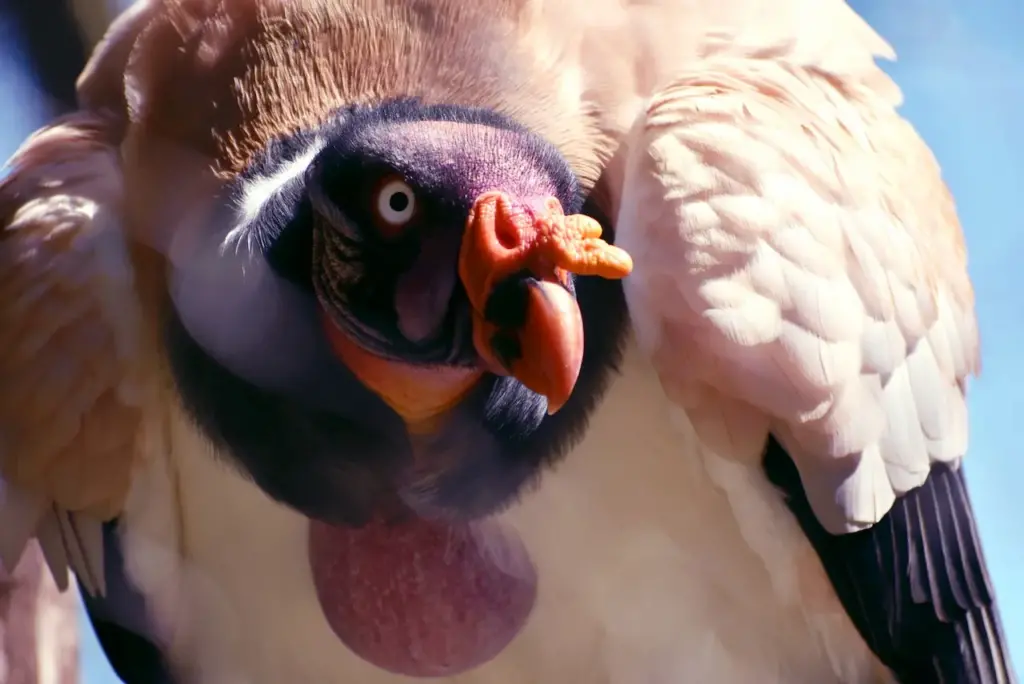
Conservation
This bird is a species of Least Concern to the IUCN, with an estimated range of 14,000,000 square kilometres (5,405,430 sq mi) and between 10,000 and 100,000 wild individuals. However, there is evidence that suggests a population decline, though it is not significant enough to cause it to be listed. This decline is due primarily to habitat destruction and poaching.
Relationship with humans
The King Vulture is one of the most common species of birds represented in the Mayan codices. Its glyph is easily distinguishable by the knob on the bird’s beak and by the concentric circles that make up the bird’s eyes.
Sometimes the bird is portrayed as a god with a human body and a bird head. According to Mayan mythology, this god often carried messages between humans and the other gods. It is also used to represent Cozcaquauhtli, the thirteenth day of the month in the Mayan calendar.
Rural South Americans believed that if the shadow of a King Vulture fell on a person, that person would suffer misfortune or death. The bird’s blood and feathers were also used to cure diseases.
The King Vulture is also a popular subject on the stamps of the countries within its range. It appeared on a stamp for El Salvador in 1963, Belize in 1978, Guatemala in 1979, Honduras in 1997, Bolivia in 1998, and Nicaragua in 1999.
Because of its large size and beauty, the King Vulture is an attraction at zoos around the world. It breeds well in captivity, but the captive vultures tend to kill their hatchlings. This habit has not been observed in the wild.
Determining the sex of a newborn bird in captivity is difficult due to the large amount of “baby fat” present in the first six months and the lack of gonadal development in the bird’s first year. The King Vulture is one of the few bird species with an AZA studbook, which as of 2007 is kept by Brian Tierney of the Bronx Zoo.

